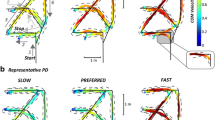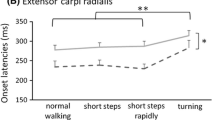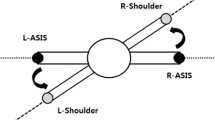Abstract
The present study compared kinematic strategies for making sudden directional changes during walking between patients with Parkinson’s disease (PwPD) and age-matched controls. Ten PwPD and 10 healthy elderly were visually cued to walk straight or to turn either 30° or 60° to the left or right, at the mid-point of a 9-m walkway. Three-dimensional kinematic data recorded: (1) the onset time of body segments in response to the turning cue, and (2) step width at the first ipsilateral foot contact (IFC1) marking the beginning of turn, the subsequent contralateral foot contact (CFC), and the second ipsilateral foot contact (IFC2) marking the completion of turn. For both 30° and 60° turns, PwPD had later onset times for lateral foot displacement, and larger time lags between the onset of body CoM and the lateral foot translation than healthy subjects (P < 0.05). Furthermore, PwPD had a significantly narrower step width than healthy subjects (P < 0.05). Despite these differences, PwPD and control subjects scaled up turning speed and amplitude similarly for 30° and 60° turns. Our findings suggested that PwPD manifested specific difficulty in modifying their ongoing motor program to switch their locomotion from straight line to sideway direction, but their ability to scale movement speed and amplitude appeared to be preserved.



Similar content being viewed by others
References
Bennett KMB, Adler CH, Stelmach GE, Castiello U (1993) A kinematic study of the reach-to-grasp movement in a subject with hemi-Parkinson’s disease. Neuropsychologia 31:709–716
Bennett KMB, Marchetti M, Iovine R, Castiello U (1995) The drinking action of Parkinson’s disease subjects. Brain 118:959–970
Beuter A, Carriere L, McFadyen B, Gauthier S (1992) The organization of stepping in patients with Parkinson’s disease: bradykinesia or discoordination? Can J Neurol Sci 19:8–16
Bloem BR, Grimbergen YAM, Cramer M, Willemsen M, Zwinderman AH (2001) Prospective assessment of falls in Parkinson’s disease. J Neurol 248:950–958
Cao C, Ashton-Miller JA, Schultz AB, Alexander NB (1997) Abilities to turn suddenly while walking: effects of age, gender, and available response time. J Gerontol Med Sci 52A:M88–M93
Castiello U, Bennett KMB (1994) Parkinson’s disease: reorganisation of the reach-to-grasp movement in response to perturbation of the distal motor patterning. Neuropsychologica 32:1367–1382
Dietz V, Colombo G (1998) Influence of body load on the gait pattern in Parkinson’s disease. Mov Disord 13:255–261
Dietz V, Duysens J (2000) Significance of load receptor input during locomotion: a review. Gait Posture 11:102–110
Dietz V, Schubert M, Trippel M (1992) Visually-induced destabilization of human stance:neuronal control of leg muscles. Neuroreport 3:449–452
Dietz V, Zijlstra W, Prokop T, Berger W (1995) Leg muscle activation during gait in Parkinson’s disease: adaptation and interlimb coordination. Electroencephalogr Clin Neurophysiol 97:408–415
Dietz V, Leenders KL, Colombo G (1997) Leg muscle activation during gait in Parkinson’s disease: influence of body unloading. Electroencephalogr Clin Neurophyiol 105:400–405
Dimitrova DM, Horak FB, Nutt JG (2004a) Abnormal force patterns for multidirectional postural responses in patients with Parkinson’s disease. Exp Brain Res 156:183–195
Dimitrova DM, Horak FB, Nutt JG (2004b) Postural muscle responses to multidirectional translation in patients with Parkinson’s disease. J Neurophysiol 91:491–501
Ehara Y, Fujimoto H, Miyazaki S, Mochimaru M, Tanaka S, Yamamoto S (1997) Comparison of the performance of 3D camera systems II. Gait Posture 5:251–255
Flowers KA (1975) Ballistic and correlative movements on an aiming task: intention tremor and Parkinsonian movement disorders compared. Neurology 25:413–421
Folstein MF, Folstein SE, Mchugh PR (1975) “Mini-Mental State”: a practical method for grading the cognitive state of patients for the clinician. J Psyhiatr Res 12:189–198
Frank JS, Horak FB, Nutt J (2000) Centrally initiated postural adjustments in Parkinsonian patients on and off levodopa. J Neurophysiol 84:2440–2448
Giladi N, NcMahon D, Prerzedborski S, Flaster E, Guiloory S, Kostic V, Fahn S (1992) Motor blocks in Parkinson’s disease. Neurology 42:333–339
Gutierrez-Farewik EM, Bartonek A, Saraste H (2006) Comparison and evaluation of two common methods to measure centre of mass displacement in three dimensions during gait. Human Mov Sci 25:238–256
Hallett M, Khoshbin S (1980) A physiological mechanism of bradykinesia. Brain 103:301–314
Hase K, Stein RB (1999) Turning strategies during human walking. J Neurophysiol 81:2914–2922
Henry SM, Fung J, Horak FB (1998) EMG responses to maintain stance during multidirectional surface translation. J Neurophysiol 80:1939–1950
Hoehn MM, Yahr MD (1967) Parkinsonism: onset, progression and mortality. Neurology 17:427–442
Horak FB, Frank J, Nutt J (1996) Effects of dopamine on postural control in Parkinsonian subjects: scaling, set and tone. J Neurophysiol 75:2380–2396
Hughes AJ, Daniel SE, Kilford L, Lees AJ (1992) Accuracy of clinical diagnosis of idiopathic Parkinson’s disease: a clinico-pathological study of 100 cases. J Neurol Neurosurg Psychiatry 55:181–184
Huxham F, Baker R, Morris M, Iansek R (2008) Footstep adjustments used to turn during walking in Parkinson’s disease. Mov Disord. doi:10.1002/mds.21932
Mak MKY, Hui-Chan CWY (2004) Audio-visual cues can enhance sit-to-stand in patients with Parkinson’s disease. Mov Disord 19:1012–1019
Mak MKY, Hui-Chan CWY (2005) The speed of sit-to-stand can be modulated in Parkinson’s disease. Clin Neurophysiol 116:780–789
Marsden CD (1982) The mysterious motor function of the basal ganglia: The Robert Wartenberg lecture. Neurology 32:514–539
Marsden CD, Obeso JA (1994) The functions of the basal ganglia and the paradox of stereotaxic surgery in Parkinson’s disease. Brain 117:877–897
Martin M, Shinberg M, Kuchibhatla M, Ray L, Carollo JJ, Schenhman ML (2002) Gait initiation in community-dwelling adults with Parkinson’s disease: comparison with older and younger adults without the disease. Phys Ther 82:566–577
Mesure S, Azulay JP, Pouget J, Amblard B (1999) Strategies of segmental stabilization during gait in Parkinson’s disease. Exp Brain Res 129:573–581
Morris ME, Iansek R, Matyas T, Summers JJ (1994a) The pathogenesis of gait hypokinesia in Parkinson’s disease. Brain 117:1169–1181
Morris ME, Iansek R, Matyas TA, Summers JJ (1994b) Ability to modulate walking cadence remains intact in Parkinson’s disease. J Neurol Neurosurg Psychiatry 57:1532–1534
Morris ME, Iansek R, Matyas TA, Summers JJ (1996) Stride length regulation in Parkinson’s disease, normalization strategies and underlying mechanisms. Brain 119:551–568
Nieuwboer A, De Weerdt W, Dom R, Lesaffee E (1998) A frequency and correlation analysis of motor deficits in Parkinson patients. Disabil Rehabil 20:142–150
Patla AE, Adkin A, Ballard T (1999) Online steering: coordination and control of body centre of mass, head and body reorientation. Exp Brain Res 129:629–634
Portney LG, Walkins MP (2000) Foundations of clinical research: applications to practice, 2nd edn. Appleton and Lange, Stamford
Stack E, Ashburn A (1999) Fall events described by people with Parkinson’s disease: implications for clinical interviewing and the research agenda. Physiol Res Int 4:190–200
Stack EL, Asburn AM, Jupp KE (2006) Strategies used by people with Parkinson’s disease who reported difficulty turning. Parkin Relat Disord 12:87–92
Tresilian JR, Stelmach GE, Alder CH (1997) Stability of reach-to-grasp movement patterns in Parkinson’s disease. Brain 120:2093–2111
Vaugoyeau M, Viallet F, Aurenty R, Assaiante C, Mesure S, Massion J (2006) Axial rotation in Parkinson’s disease. J Neurol Neurosurg Psychiatry 77:815–821
Willems AM, Nieuwboer A, Chavret F, Desloovere K, Dom R, Rochester L, Kwakkel G, van Wegen E, Jones D (2007) Turning in Parkinson’s disease patients and controls: The effect of auditory cues. Mov Disord. doi:10.1002/mds.21445
Winter DA (1995) A.B.C anatomy, biomechanics and control of balance during standing and walking. Waterloo Biomechanics, Waterloo
Zijlstra W, Rutgers AWF, van Weerden TW (1998) Voluntary and involuntary adaptation of gait in Parkinson’s disease. Gait Posture 7:53–63
Acknowledgments
The authors wish to acknowledge research grants given by The Hong Kong Polytechnic University (A-PF27 and G-T924), Hong Kong Parkinson’s disease Association, staff from Community Rehabilitation networks, and all research personnel: Dr. Raymond Chung, YY Wong and Man Cheung for their assistance. Our special thanks to Dr. Fay Horak for her valuable comments on the manuscript.
Author information
Authors and Affiliations
Corresponding author
Rights and permissions
About this article
Cite this article
Mak, M.K.Y., Patla, A. & Hui-Chan, C. Sudden turn during walking is impaired in people with Parkinson’s disease. Exp Brain Res 190, 43–51 (2008). https://doi.org/10.1007/s00221-008-1446-1
Received:
Accepted:
Published:
Issue Date:
DOI: https://doi.org/10.1007/s00221-008-1446-1




